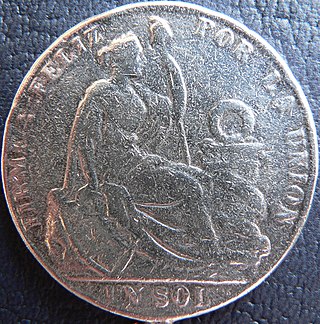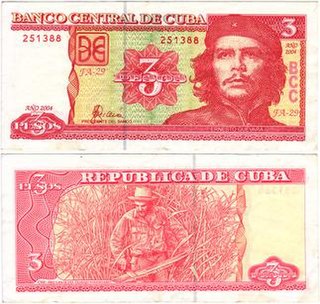
The Portuguese escudo was the currency of Portugal replacing the real on 22 May 1911 and was in use until the introduction of the euro on 1 January 2002. The escudo was subdivided into 100 centavos. The word escudo literally means shield; like other coins with similar names, it depicts the coat of arms of the state.

The córdoba is the currency of Nicaragua and is divided into 100 centavos.

The Sucre was the currency of Ecuador between 1884 and 2000. Its ISO code was ECS and it was subdivided into 10 decimos and 100 centavos. The sucre was named after Latin American political leader Antonio José de Sucre. The currency was replaced by the United States dollar as a result of the 1998–99 financial crisis.

The sol, later sol de oro, was the currency of Peru between 1863 and 1985. It had the ISO 4217 currency code PES. It was subdivided into 10 dineros or 100 centavos. It also had two different superunits over its circulation life, the inca (1881–1882) and later the gold pound, both worth 10 soles.

The Colombian peso is the currency of Colombia. Its ISO 4217 code is COP. The official peso symbol is $, with Col$. also being used to distinguish it from other peso- and dollar-denominated currencies.

The Cuban peso also known as moneda nacional, is the official currency of Cuba.

The Dominican peso, officially the peso dominicano since 2010, is the currency of the Dominican Republic. Its symbol is "$", with "RD$" used when distinction from other pesos is required; its ISO 4217 code is "DOP". Each peso is divided into 100 centavos ("cents"), for which the ¢ symbol is used. With exception of the United States dollar, it is the only currency that is legal tender in the Dominican Republic for all monetary transactions, whether public or private.
The colón was the currency of El Salvador from 1892 until 2001, when it was replaced by the U.S. dollar during the presidency of Francisco Flores. The colón was subdivided into 100 centavos and its ISO 4217 code was SVC. The plural is "colones" in Spanish and the currency was named after Christopher Columbus, known as Cristóbal Colón in Spanish.
The peso was the currency of Paraguay between 1856 and 1944. It replaced the real at a rate of 8 reales = 1 peso. Until 1870, the peso was subdivided into 8 reales. Paraguay then decimalized, with 100 centésimos = 1 peso. The name of the subdivision was changed to centavo in 1874. The peso was replaced in 1944 by the guaraní at a rate of one hundred to one.

The peso was the currency of Costa Rica between 1850 and 1896. It was initially subdivided into 8 reales and circulated alongside the earlier currency, the real, until 1864, when Costa Rica decimalized and the peso was subdivided into 100 centavos. The peso was replaced by the colón at par in 1896

The peso was the currency of Honduras between 1862 and 1931.

The escudo was the currency of São Tomé and Príncipe between 1914 and 1977. It was equivalent to the Portuguese escudo and subdivided into 100 centavos.

The venezolano was the currency of Venezuela between 1872 and 1879. It was divided into 100 centavos, although the names céntimo and centésimo were also used. Venezolano was also the name of two currencies planned in 1854 and 1865.

The peso was a currency of Venezuela until 1874. It was subdivided into 10 reales, each of 10 centavos.

The escudo was the currency of Portuguese Timor between 1959 and 1976. It replaced the pataca at a rate of 5.6 escudos = 1 pataca and was equivalent to the Portuguese escudo. It was replaced by the Indonesian rupiah at an unknown exchange rate following East Timor's occupation by Indonesia. The escudo was subdivided into 100 centavos.

The escudo was the currency of Angola between 1914 and 1928 and again between 1958 and 1977. It was subdivided into 100 centavos with the macuta worth 5 centavos and was equivalent to the Portuguese escudo.
The real was the currency of Argentina until 1881. From 1822, it was subdivided into 10 décimos. The sol was also issued during this period and was equal to the real, whilst the peso was worth 8 reales and the escudo was worth 16 reales.
The peso was the currency of El Salvador between 1877 and 1919.

The peso was a currency of Ecuador until 1884.
The peso moneda nacional was the currency of Argentina from 5 November 1881 to 1 January 1970, the date in which the peso ley 18.188 was issued to the Argentine public. It was subdivided into 100 centavos, with the argentino worth 5 pesos. The peso was introduced to replace the Argentine peso moneda corriente at a rate of $+m⁄c 25 = m$n 1.















